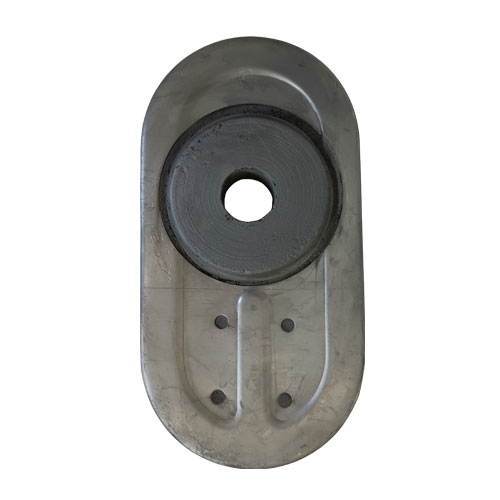A wide variety of refractory materials are used in the steelmaking process. They are primarily used to line the vessels holding molten iron and steel, as well as provide necessary furnace protection and insulation. These materials include ladle linings, converter linings, ladle linings, and tundish linings, along with a range of supporting shaped refractory materials such as tapholes, sliding nozzles, and continuous casting components. Furthermore, there are over 130 types of unshaped bulk materials, including filler material, refractory clay, dry material, casting material, drainage sand, covering agents, and mold slag.
The ladle, a key piece of equipment in the steelmaking process, receives hot molten iron from the blast furnace’s taphole and feeds it into the converter for further smelting. The molten iron, which reaches temperatures of approximately 1200-1370°C, undergoes drastic thermal shocks during its service. Therefore, the refractory materials used in the ladle must possess excellent heat resistance to withstand frequent thermal shocks while maintaining sufficient rigidity to prevent disintegration or cracking during cooling and heating.
1.Brick lined iron bag
The working layer of brick-lined ladles primarily utilizes low-aluminum silicon carbide carbon bricks, which not only offer excellent scouring resistance but also effectively prevent slag sticking. Compared to the magnesia carbon bricks used in steel ladles, these brick-lined ladles are more affordable and offer superior performance. Furthermore, brick-lined ladles are particularly well-suited for railway transportation of molten iron, meeting specific usage requirements.
2.Integral cast iron ladle
The ladles used for mixing molten iron in the factory are cast in one piece using Al-SiC castables. These ladles have a tight operating cycle. While they may not be as resistant to extreme temperature fluctuations as rail-transported ladles, they offer a longer service life. In recent years, by increasing the thickness of the impact zone at the bottom of the ladles and applying an anti-slag agent to the lap opening, the lifespan of the ladles has been further extended, minimizing the impact of slag buildup on the lap opening.
Ladles are crucial equipment in steel production. They not only transport high-temperature molten steel but also play a key role in the refining process outside the furnace.
The temperature of the molten steel in the ladle is maintained between 1550 and 1620°C. This high-temperature environment forces the ladle to withstand severe thermal shock during its service life. Due to the extremely harsh operating conditions of the refining ladle, the arc erodes the slag line and ladle walls severely, often leading to premature damage to the refractory material and becoming a key factor affecting the ladle’s service life. Therefore, compared to the brick lining of the iron ladle, the requirements for the brick lining of the steel ladle are more stringent.
- Permanent Ladle Lining
The ladle utilizes a corundum-spinel castable as its permanent lining. This material not only offers excellent resistance to slag erosion and penetration, but also exhibits excellent spalling resistance. This effectively resists these erosion damages, ensuring the ladle’s stability throughout its service life. Currently, the permanent ladle lining maintains a service life of approximately 1.5 years.
- Working Ladle Lining
The working ladle lining is primarily constructed of aluminum-magnesium (carbon) refractory materials, designed to enhance the ladle’s durability. To ensure the ladle’s overall service life, the refractory materials in core components such as the slag line bricks, breather bricks, slide plates, and nozzle bricks must be consistent with the lifespan of the ladle lining.
- Bottom-blown Breather Bricks
Breather bricks are pre-embedded in the ladle’s bottom. Argon gas agitation ensures uniform temperature and composition of the molten steel and promotes the floating of non-metallic inclusions. The breather bricks feature a slotted design, ensuring smooth replacement of two permeable bricks during the ladle’s service life.

- Ladle Inlet and Slide Plate
The ladle inlet, as the essential path for molten steel to flow from the ladle into the tundish, is of paramount importance. Furthermore, the slide plate, a key component for controlling the flow of molten steel into the tundish, requires particularly stringent material selection. In actual production, both components are made of magnesium-carbon materials to ensure durability and functionality. However, over time, these components may wear or corrode, impacting their service life and process requirements. Therefore, they must be replaced as necessary to ensure smooth casting.

3.Tundish
The temperature of the molten steel in the tundish is maintained between 1470°C and 1560°C. After casting, a certain thickness of excess steel is retained to ensure smooth operation for the next casting. However, during production, the stopper rod and excess steel can freeze inside the tundish. Therefore, the entire tundish, along with the working lining, must be removed after cooling, meaning the working lining is scrapped after a single use. Therefore, the durability requirements for the tundish working lining are slightly lower than those for the ladle.
- Permanent Lining Casting Material
The permanent lining of the tundish is typically made of an aluminum-silicon castable. This castable must possess excellent strength, volumetric stability, and thermal shock resistance to withstand the tundish’s operating environment. Currently, D57 castable is commonly used for tundishes, with a service life of approximately 700 to 805 furnaces.
- Dry Working Lining Material
Magnesium dry working lining for tundishes is widely used due to its ease of construction, high baking thermal efficiency, and easy separation of slag from the permanent lining. Its use not only increases the tundish’s turnover rate and optimizes molten steel quality, but also significantly extends its service life. The main component of this dry charge is fused magnesia, and its dosage is precisely controlled according to the steel grade and the age of the tundish, typically between 10 and 40 heats.
